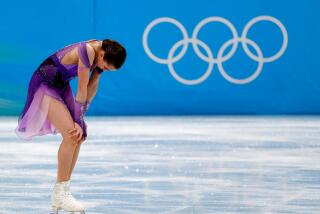More Out-of-Competition Drug Tests Conducted
- Share via
In a sign of the increasing vitality of the agency charged with freeing sport from the taint of illicit drug use, the World Anti-Doping Agency will announce today that it will have conducted 3,500 out-of-competition drug tests in the 12 months before the start of the Salt Lake Winter Olympics, including 1,200 from December through the Feb. 8 start of the Games.
Of 2,600 tests conducted through Jan. 10, 24, or about 1%, returned positive or “elevated” results, and some athletes with elevated numbers may have been previously authorized to take certain medicines, the WADA report will say.
It would be foolhardy, however, for anyone interested in Olympic sports to pretend that these numbers show that WADA, created two years ago in the wake of the doping scandal at the 1998 Tour de France cycling event, already is catching all but a few cheaters.
For at least the last 35 years, athletes, coaches and trainers have been aggressively pushing the boundaries of scientific and medical research in an effort to stay one step ahead of the International Olympic Committee and other authorities. The current performance-enhancing substances of choice include human growth hormone and EPO, a synthetic hormone that boosts red blood cell production and thus enables athletes to train harder and longer.
Already, however, WADA has conducted more EPO tests in advance of the Salt Lake Games than the 200 or so it did in the run-up to the Sydney Summer Games in 2000, according to WADA Chairman Dick Pound, an IOC member from Canada. None of the 200-plus tests has returned yet a positive result.
Meantime, the report, due to be issued today in Montreal, WADA’s new headquarters, plainly shows that WADA has--perhaps for the first time--focused the attention of sports and government officials worldwide on athletes’ use of banned substances.
“WADA has come a sight farther than anyone thought possible and there is growing enthusiasm in the sport community and the public at large for the Olympics to be a humanistic, as opposed to chemical, triumph,” Pound said in a telephone interview Thursday.
The challenge is so formidable that even IOC President Jacques Rogge recently expressed doubt that the doping war can be won. A significant issue in the coming months--though largely legalistic and decidedly unglamorous--is to effect a uniform anti-doping code worldwide; Pound said the goal is to have it in place by the Athens 2004 Summer Games.
“I think it will be won, oddly enough,” Pound said.
Other signs of WADA’s viability include agreements with 34 of the 35 international sports federations on the Olympic program. The holdout is FIFA, soccer’s worldwide governing body; Pound said an agreement in principle has been reached but not yet signed.
WADA’s budget, $6 million in its first year, will reach $18.2 million this year. Tests were conducted last year in 46 countries, on athletes from 75 nations.
The report is being issued in conjunction with WADA’s avowed intent to make the Salt Lake Games “the most drug-free in Olympic history” and a slogan: “At the Olympics, we want heroes, not just winners.”
Pound said: “That does encapsulate a lot of what I personally feel. You’re dealing with a humanistic activity and it shouldn’t be who can ingest the most chemicals that determines the outcome. You want it to be fair. You want it to be healthy.”
Months ago, Salt Lake Organizing Committee President Mitt Romney said he wanted 100% of the 2,400 athletes expected at the Winter Olympics to have been subjected to an out-of-competition test before the Games begin--by WADA, an international sports federation or other authority. While some critics have said that 100% is grossly optimistic in part because of the large pool of Olympic hopefuls, Romney said this week he believes it is still possible.
Out-of-competition tests are a key to eliminating athlete drug use because they are no-notice tests.
But they also are problematic. The reality, as WADA testers have discovered, is that sometimes an athlete isn’t where the testers expect him or her to be--and, for any number of reasons, some legitimate, some suspicious, the athlete simply can’t be found.
More to Read
Go beyond the scoreboard
Get the latest on L.A.'s teams in the daily Sports Report newsletter.
You may occasionally receive promotional content from the Los Angeles Times.






